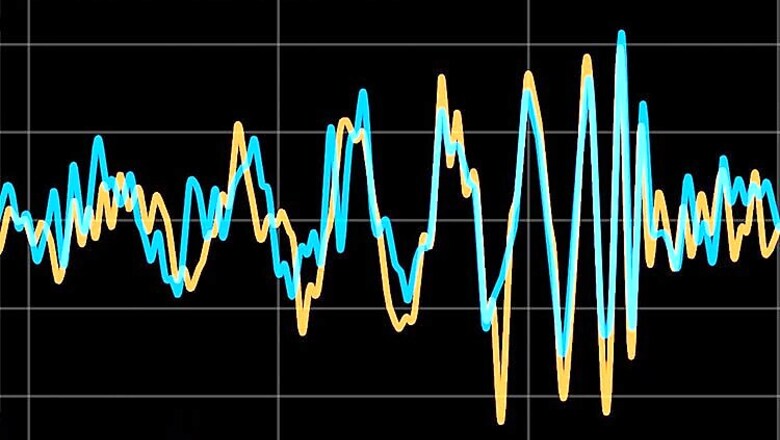
views
Great excitement rippled through the physics world as astronomers on Thursday announced that their new billion-dollar US observatory has detected a gravitational wave, a phenomenon Albert Einstein predicted a century ago in his theory of general relativity.
Here's what that breakthrough means.
Q: What are gravitational waves?
A: Gravitational waves are extremely faint ripples in the fabric of space and time that come from some of the most violent events in the universe. In this case, it is from the merger of two black holes 1.3 billion light-years away. The way to think of this is to imagine a mesh net and visualize pulling on its ends. Those kinks are sort of like what a gravitational wave does.
Albert Einstein predicted gravitational waves in his general theory of relativity a century ago. Under this theory, space and time are interwoven into something called "spacetime" - adding a fourth dimension to our concept of the Universe, in addition to our 3D perception of it.
Einstein predicted that mass warps space-time through its gravitational force. A common analogy is to view space-time as a trampoline, and mass as a bowling ball placed on it. Objects on the trampoline's surface will "fall" towards the centre - representing gravity.
 Massive bodies warp space-time: How our sun and Earth warp space and time, or spacetime, is represented here with a green grid. (Image: LIGO)
Massive bodies warp space-time: How our sun and Earth warp space and time, or spacetime, is represented here with a green grid. (Image: LIGO)
When objects with mass accelerate, such as when two black holes spiral towards each other, they send waves along the curved space-time around them at the speed of light, like ripples on a pond.
The more massive the object, the larger the wave and the easier for scientists to detect.
Gravitational waves do not interact with matter and travel through the Universe completely unimpeded.
The strongest waves are caused by the most cataclysmic processes in the Universe - black holes coalescing, massive stars exploding, or the very birth of the Universe some 13.8 billion years ago.
Q: Why is the detection of gravitational waves important?
A: It ended the search for proof of a key prediction in Einstein's theory, which changed the way that humanity perceived key concepts like space and time.
Detectable gravitational waves open exciting new avenues in astronomy - allowing measurements of faraway stars, galaxies and black holes based on the waves they make.
Indirectly, it also adds to the evidence that black holes - never directly observed - do actually exist.
So-called primordial gravitational waves, the hardest kind to detect and not implicated in Thursday's announcement, would boost another leading theory of cosmology, that of "inflation" or exponential expansion of the infant Universe.
Primordial waves are theorised to still be resonating throughout the Universe today, though feebly.
If they are found, they would tell us about the energy scale at which inflation ocurred, shedding light on the Big Bang itself.
Q: Why are gravitational waves they so elusive?
A: Einstein himself doubted gravitational waves would ever be detected given how small they are.
Ripples emitted by a pair of merging black holes, for example, would stretch a one-million-kilometre (621,000-mile) ruler on Earth by less than the size of an atom.
-
Waves coming from tens of millions of lightyears away would deform a four-kilometre light beam such as those used at the Advanced Laser Interferometer Gravitational Wave Observatory (LIGO) by about the width of a proton.
Q: How have we looked for them?
A: Before now, gravitational waves had only been detected indirectly.
In 1974, scientists found that the orbits of a pair of neutron stars in our galaxy, circling a common centre of mass, were getting smaller at a rate consistent with a loss of energy through gravitational waves.
That discovery earned the Nobel Physics Prize in 1993. Experts say the first direct detection of gravitational waves is likely to be bestowed the same honour.
After American physicist Joseph Weber built the first aluminium cylinder-based detectors in the 1960s, decades of effort followed using telescopes, satellites and laser beams.
Earth - and space-based telescopes have been trained on cosmic microwave background, a faint glow of light left over from the Big Bang, for evidence of it being curved and stretched by gravitational waves.
-
Using this method, American astrophysicists announced two years ago they had identified gravitational waves using a telescope called BICEP2, stationed at the South Pole. But they later had to admit they made an error.
Another technique involves detecting small changes in distances between objects.
 The approximate location of the source of gravitational waves detected on September 14, 2015, by the twin LIGO facilities is shown on this sky map of the southern hemisphere. (Image: LIGO)
The approximate location of the source of gravitational waves detected on September 14, 2015, by the twin LIGO facilities is shown on this sky map of the southern hemisphere. (Image: LIGO)
Gravitational waves passing through an object distort its shape, stretching and squeezing it in the direction the wave is travelling, leaving a telltale, though miniscule, effect.
Detectors such as LIGO at the centre of Thursday's news, and its sister detector Virgo in Italy, are designed to pick up such distortions in laser light beams.
 Gravitational-wave observatories across the globe. A sixth observatory is being planned in India. (Image: LIGO)
Gravitational-wave observatories across the globe. A sixth observatory is being planned in India. (Image: LIGO)
At LIGO, scientists split the light into two perpendicular beams that travel over several kilometres to be reflected by mirrors back to the point where they started.
Any difference in length upon their return would point to the influence of gravitational waves.
Q: How is this "hearing" the cosmos?
A: Scientists mostly use the word "hear" when describing gravitational waves, and the data does, in fact, arrive in audio form. The researchers can don headphones and listen to the detectors' output if they want. On Thursday, to prove they found a gravitational wave, the researchers played a recording of what they called a chirp.
-
Q: How can they be certain this is real?
A: Astronomers sat on the discovery for nearly five months, since September 14, checking back and forth to make sure it was right. They considered all sorts of Earth-bound interference or noise, examined the possibilities and eventually dismissed them.
The astronomers are so cautious that they routinely have other scientists deliberately inject false data to test their abilities. In those tests, the observatory team was able to show that the injected data wasn't real. In the case of the discovery announced Thursday, they are extra certain they are not seeing injected or hacked data because the system that allows false information to be inserted was down at the time.
In addition, the team of 1,004 scientists on the project looked over the data, and the results were then peer-reviewed by even more experts and published in the journal Physical Review Letters.
What's next?
A: Expect more waves. It could be as many as a few a month or as little as a few per year. The observatory is also being further upgraded to hear even fainter, more distant waves.
(With inputs from agencies)




















Comments
0 comment